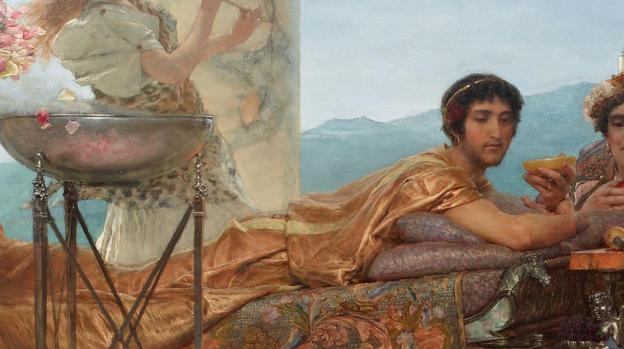Heliogála, the transsexual emperor
It was born in Emesa, the current homs located in the current Syria in the year 203 D.C.He was a noble and Roman priest, who arrived in Emperor and belonged to the severe dynasty.Reigned since 218 D.C.Until the year 222 D.C.By becoming an emperor he took the name of Marco Aurelio Antonino Augusto and was only known as Heliogála long after his death.
Era hijo de Sexto Vario Marcelo que pertenecía a la orden ecuestre y posteriormente alcanzó el rango de Senador y su madre Julia Soemia Basiana era prima del emperador romanoCaracalla.
For his part, his maternal aunt was Julia M processa (in the image), who was married to the aristocrat, Marco Julio Gesio Marciano and their son was his cousin and successor, Emperor Alejandro Severo.
Heliogábalo's family had hereditary rights to the priesthood of the Sun God, the-Gabal, of whom Heliogábalo was a great priest in his hometown of Homs.
The name El-Gabal initially referred to the patron of the birthplace of the emperor."The" refers to the main semi -dealer, while "Gabal", which means mountain and is its manifestation of homs.
God was later taken to Rome and assimilated with the only solar God, who was known as Sol Indiges in the Republican era, and later Sol Invictus during the second and III centuries.Thus, he adopted the name of God, calling himself "elagabalus".
His arrival to power
Cuando el emperador Macrino tomó el poder, quiso eliminar la amenaza que suponía la familia sobreviviente deCaracalla, enviándolos al exilio.Julia Mesa, her two daughters and her eldest grandson, Heliogábalo, were sent to their rural Homs residence.
Once settled there, Julia Mesa began plotting a plot along with her advisor Eunuco and Tutor of Heliogábalo, General Gannys to overthrow the emperor Macrino and place Heliogábalo, who only had fourteen years of age, on the imperial throne.
Heliogábalo y su madre se adhirieron a las pretensiones de Julia Mesa y fraguaron la mentira de que Heliogábalo era hijo ilegítimo deCaracalla, por lo que los partidarios del otrora emperador le debían lealtad ahora al adolescente.
After Julia Mesa exhibited her wealth before the III Gémine Legio parked in Raphana in Syria, she swore loyalty to Heliogála.At dawn of May 16, 218 D.C., Publio ValerioComazón Eutiquiano, comandante de la legión, declaró emperador al joven Heliogábalo.
Para fortalecer su legitimidad a través de más propaganda, Heliogábalo asumió los nombres con los que se identificabaCaracalla, Marco Aurelio Antonino.
Emperor Macrino sent Syria to his prefect of the Pretorio, Ulpio Julian.
However, this force soon rebelled against the emperor and adhered to the loyal troops to Heliogábalo when, during the battle, they declared uprising before their commanders.The officers were killed and Juliano's head was sent back to the emperor.
Then, Macrino sent letters to the Senate, arguing that the alleged ancestry of Heliogábalo was false and claiming madness in his rival.Thus he got Heliogála be convicted of the consuls and other Roman leaders, and the Senate therefore declared war on both Heliogábalo and Julia Mesa.
Emperor Macrino and his son, found themselves very weakened by the drop -out of the II Legion due to the bribes and promises launched by Julia Mesa.Emperor Macrino was defeated, on June 8, 218 D.C., in the battle of Antioquia for troops led by General Gannys.
Heliogábalo Emperor Sculpture in the Vatican Museums
El emperador Macrino huyó hacia la península Itálica, disfrazado de mensajero, pero fue más tarde interceptado cerca deCalcedonia y ejecutado enCapadocia.His son, Dadumenian, was sent for his security to the court of the Empire delivery.However, he was captured in Zeugma and also executed.
The Emperor Heliogábalo declared the date of victory in Antioch as the beginning of his reign and assumed the imperial titles without the prior approval of the Senate, which violated tradition, but that was not an isolated fact between theCaesars of the third century.
Reconciliation letters to Rome were sent, extending the amnesty to the Senate and recognizing the laws, and at the same time condemning the administration of Emperor Macrino and his son. Los senadores respondieron reconociendo a Heliogábalo como emperador y reconociéndolo finalmente como hijo deCaracalla.
Caracalla and Julia Domna were deified by the Senate, while both Julia Mesa and Julia Soemia were elevated to the range of augusts, and the memory of Macrino and Diadumenian was condemned and vilified by the Senate. El anterior comandante de la Tercera Legión,Comazón, fue nombrado comandante de la Guardia pretoriana.
Heliogábalo's mother, Julia Soemia.Bust of the Vatican Museums
PRIMER AÑOCOMO EMPERADOR
Upon the arrival of Heliogábalo to Rome, many of the loyal ones to Emperor Macrino were executed.However, many members of the Senate supporters of the previous emperor were left alone.Other high -ranking imperial officers were dismissed and replaced by unleashed faithful from Syria.
Of course, the daily activities of the government were ignored by the young ruler and these political tasks were left to his mother and grandmother.Both were awarded the title of Augusta and even permission to attend the Senate sessions.Comazón, quien los había acompañado a Roma, fue nombrado prefecto de la guardia pretoriana.
Heliogábalo and his court passed the winter of the year 218 D.C.In Bitinia de Nicomedia, where the religious practices and convictions of the new emperor became evident, stating that they would be a real problem.
El historiador contemporáneo DiónCasio sugiere que el general Gannys fue asesinado por el nuevo emperador debido a que estaba forzando a Heliogábalo a vivir de forma mesurada y prudentemente.
To help the Roman people to adapt to the idea of having an oriental priest as an emperor, Julia Mesa made Rome a portrait of heliogábalSenate.
This put the senators in an uncomfortable position, because at the same time they made offerings to the goddess, they were revereding the emperor.The legions were dismayed at their behavior and quickly regretted their decision to have supported him as an emperor.
While Heliogábalo was still on the way to Rome, small revolts broke out in the IV Gémine Legion instigated by Senator Gelio Máximo, who intended to usurp the power.The III Gémine Legion, which was the same that was proclaimed Emperor under the command of Senator Vero also revolted.The rebellion was quickly crushed, and the III Gémine Legion was dissolved and its retired members.
Heliogábalo entrance in Rome
When theCourt finally arrived in Rome in autumn of the year 219 D.C.,Comazón y otros aliados de Julia Mesa y Heliogábalo recibieron cargos importantes y lucrativos, lo que generó irritación en muchos senadores, que no los consideraban respetables.
Después de ejercer como prefecto del pretorio,Comazón ejerció en tres ocasiones como prefecto de la ciudad de Roma, y dos como cónsul. Heliogábalo intentó también que su esclavo, Hierocles fuese nombradoCésar, mientras su presunto amante Zotico, fue nombrado cubiculario (1), cargo que si bien no era administrativo, si era muy influyente.
His amnesty offer for Roman leaders was acclaimed, although the Ulpian jurist was exiled.Heliogábalo ties with Julia Mesa and Julia Soemia were strong.

His mother and grandmother became the first women in the history of Rome who were admitted to the Senate, and both received senatorial titles. Se dio el título tradicional deClarissima a Julia Soemia y el menos ortodoxo de MaterCastrorum et Senatus a Mesa.
The most hated emperor in Rome, defended women to some extent.The first day that the Senate celebrated its routine assembly ordered that its mother attend, a totally unusual fact in the history of Rome.
When he arrived at the Senate, he took a place next to the consuls' seat and was present in the writing of the Senate decree.Thus, the Emperor Heliogábalo became the only emperor under whose government a woman was admitted in the Senate, occupying a man's own range.(In the image: Roman denarius with the supposed effigy of the Emperor Heliogála).
In this way, the emperor also institutionalized a Senate for women, locating it in the chirinal hill, where the midwives were held.
His grandmother tried to settle as the power in the shadow and, therefore, as the most powerful woman in the Roman world, but the independence of Heliogábalo became evident.
The most decisive of their faults, however, would surely be the power that women obtained during their kingdom.The effective government of Rome, in fact, is attributed during the Heliogábalo government more to female gynece after purple than to the laurels themselves, especially to their aunt Julia Momea, his mother Julia Soemia and her grandmother Julia Masca.
From the reign of Septimio Severo, the cult of the solar god had spread through the empire.Heliogábalo saw in it an opportunity to make his God, the-gabal, the main deity of the Roman pantheon.The God was renamed God Sun undict, and was imposed even above Jupiter.
As a sign of the union with the Roman religion, Heliogábal.
The emperor caused a greater scandal when he married the Virgin Vestal (2) Aquilia Severa, arguing that marriage would produce children similar to the gods.The fact flagrantly broke Roman law and tradition, since any vestal that had sex had to be buried alive.
A luxurious temple called Elagabalium was built on the eastern slope of the palatine to house El-Gabal, which was represented by a black conical meteorite of Homs, which had a penis shape.Speaking of this stone, Herodiano the Stoic said:
"This stone is venerated as if it had been sent from heaven, on it there are some outstanding pieces and brands that are highlighted, with respect to which the people intend to believe that they are an image of the sun, because that is how they see them.".
In order to become the high priest of his new religion, Heliogábalo became circumcised.Herodiano reports that he forced the senators to contemplate their dance before the altar of Deus Sol Invictus to the touch of drums and cymbals, and each summer solstice of his reign celebrated a great festival in honor of the deity, which became very popular among themasses because they were distributed food in abundance.During this festival, the Emperor Heliogábalo placed his god-barrage in a carriage adorned with gold and jewels, which paraded through the city.Herodian the Stoic said:
“A car pulled by six horses carried divinity, huge horses and pure white, with expensive golden arrans and rich ornaments.No one held the reins, and nobody wore the car;The vehicle was escorted as if God himself were the auriga.Heliogábalo ran backwards in front of the car, looking at God, and holding the reins of horses.Towards the whole trip in this way, to the regs, looking at the face of his God ”.
The most sacred relics of the Roman religion were transferred from their respective sanctuaries to Elagabalium, including the great mother, the fire of Vesta, the shields of the saliar (3) and the paladium, to make any other God except the-gabal outVenerated.
ElCuadro “Las rosas de Heliogábalo” (1888),de Sir Lawrence Alma-Tadema
Se ha asociado esta reforma religiosa, así como el traslado a Roma del betilo de El-Gabal en Homs, con cierto fenómeno astronómico que los augures habrían interpretado como un presagio acerca del nuevo emperador: el perihelio delCometa Halley, a diecisiete de mayo del año 218 d.C., just on the day after the proclamation of Heliogábalo by the Legio III Gallica.
He tells in history augusta how religious practices imported and imposed by the emperor abounded equally in the sexual and in the macabre. El emperador Heliogábalo se empeño en oficiar personalmente los cultos a las divinidades latinas de consagración principalmente Venus, Adonis oCibeles a la par que organizaba desfiles de la piedra dios en forma de pene, por ejemplo, en un carro tirado por mujeres desnudas.
Sexual controversy
Heliogábalo's sexual orientation and identity have been subject to great controversy and debate throughout history.He married five times with women, two of whom are unknown.
acai and goji bowl - LIVERCLEANSING DIET - Learn how to do a LIVER FLUSH http://t.CO/X8FCHT7NK http: // t.CO/CBJNAY6I49
— jagodygoji.com Fri Apr 05 10:56:23 +0000 2013
Su primera esposa fue JuliaCornelia Paula, la segunda fue la vestal Julia Quilia Severa, pero el mismo año, la abandonó y se casó por tercera vez con Annia Faustina, que era descendiente del emperador Marco Aurelio y viuda de un hombre recientemente ejecutado por Heliogábalo.At the end of the year, he had returned with severe.
Sin embargo, según DiónCasio, su relación más estable parece haber sido la que mantuvo con su auriga, un esclavo rubio deCaria, llamado Hierocles, a quien incluso se refería como su marido.
Hierocles kept his most durable relationship with Heliogála. En su Historia Romana, libroLXXX, DionCasio especifica los términos altamente bondage en los que solían desarrollarse sus amores.
“Giveput on purple eyes. Su afecto por este esposo no era una inclinación suave sino una pasión ardiente y firmemente asentada, más aún cuando después de este severo trato vejatorio, lo amaba aún más y deseaba coronarloCésar en ese mismo instante”.
DionCasio, Historia Romana.LXXX.fifteen.3-4.
The Emperor Heliogábalo referred to hierocles like her husband and came to say feel delighted "that the lover, the wife, the queen of Hoocles" call me ".Herodiano the Stoic comments that Heliogábalo was extremely vain and retouched his natural beauty wearing excess makeup.
Augusta History argues that he also married a man named Zotico, who was an Esmirna athlete, in a public ceremony in Rome.
Heliogábalo Emperor himself starred.
On one occasion "he shaved his cheeks and attended a party to point out the event, but then he started his hair to look more like a woman" to finally end up referring to himself, in fact, like a woman.The story Augusta reviews not only transvestite.
Áureo coined by Heliogábalo representing the God El-Gabal
DiónCasio dice que el emperador Heliogábalo se pintaba los ojos, se depilaba y lucía pelucas para prostituirse en tabernas y prostíbulos, e incluso en el palacio imperial.
Around the year 220 D.C.However, Heliogábalo is left of absurd elaborations and begins to exercise prostitution directly.First it would be for Rome, according to the story Augusta, where "frequented the most notorious brothels expelling prostitutes to make himself with a bitch".
Según el político y militar DionCasio le gustaba ponerse pelucas y prostituirse, incluso algunos historiadores lo consideran el primer transexual de la historia.In addition, he came to practice Salambo's rites, a Syrian act that consisted of performing orgies that included "the act of castration".
Finally, the Emperor Heliogábalo reserved a room in the palace and there he committed his sexual perversions, always remaining naked in the threshold, as the prostitutes do, and moving the curtain that hung from golden rings, while in a soft and moving voiceoffered those who passed through the corridor.
As if the goddess Venus was, he dropped her dresses to her feet and put on her knees, nake.
According to Herodiano, there was the rumor that the emperor had offered huge amounts of money to the doctor who could give him female genitals.For these reasons, the Emperor Heliogábalo has been considered by modern writers as the first documented case of a transsexual person.
Sexual scene in a Pompeii brothel
One of the six authors of the Augusta History work said that he used his power to ensure that his emissaries would seek "individuals with good balls" to enjoy their qualities and liked to transvest to perform sexual acts of the most extravagant.
He transferred many individuals whose body complexion had pleased him, making them abandon the theater, the circus or the amphitheater and then shave the issues using the same knife with which he shaved.
Among the variety of lovers stood out:
The jealous emperor, because the sources described him, decided to marry both, although the Senate ended up not accepting it and his claim was to exercise as a wife.
The hatred of the senators and the town towards its emperor was not limited only to their sexual vices.He sold all kinds of titles, military command and other positions to the highest bidder and tried to abolish all the cults that were held in Rome destroying religious sanctuaries.Heliogábalo wanted to be worshiped as a god.
Edward Gibbon said of him in the year 1776 that "the most rude pleasures and fury without control were abandoned".John Stuart There is described it in the year 1911 as "Sexual Psychopath" and Robert Hans Van Gulik qualifies it in 1974 as "neurotic sadistic".
Then we would send public baths in the palace itself "and at the same time opened the people of Plauciano, in order to discover the qualities of the best sexually endowed men".
He is considered the first transsexual of which he has a certain historical testimony. Debemos destacar la mención que hace DionCasio a que “llevó su obscenidad hasta tal punto que preguntó a los médicos si podían idear la manera de introducir en su cuerpo una vagina de mujer por medio de la incisión, prometiéndoles a cambio enormes sumas de dinero”.
Fall and murder
For the year 221 D.C., the eccentricities of the Emperor Heliogábalo, especially their relationship with hierocles, increasingly enraged the Praetorian guard soldiers.
When Julia Mesa realized that popular support for the emperor was in a fast decline, he decided that both he and his mother, who had supported him in his religious practices, had to be replaced.
As an alternative, he turned to his other daughter, Julia Avita M process, and her son of thirteen, Alejandro Severo.Convenció a Heliogábalo para que adoptara a su primo como heredero, le diera el título deCésar y compartiera con él el consulado de ese año.However, Heliogábal reconsidered his decision when he began to suspect that the Praetorian guard preferred his cousin over him.
After the failure of several attacks against Alejandro's life, Heliogábalo deprived his cousin of his titles, revoked the consulate and circulated the news that Alejandro was close to death to cause a reaction in the Praetorians.
Julia Mesa
A riot was unleashed, and the Praetorian guard demanded to see Emperor Heliogáalo and Alejandro in the Praetorian countryside.The emperor agreed to it and on March 11 of the year 222 D.C.He appeared with his cousin and his mother Julia Soemia.
Upon arrival, the soldiers acclaimed Alejandro as Emperor, while ignoring Heliogábalo, who ordered a summary arrest and the execution of anyone who had intervened in this revolt. A modo de respuesta, los pretorianos atacaron a Heliogábalo y a su madre, Así relata DiónCasio estos acontecimientos:
“So he tried to flee, and he could have reached somewhere hidden in an arch, but he was discovered and killed him, at eighteen years of age.His mother, who hugged him closely, perished with him;They cut their heads and bodies, after having undressed, they first dragged them throughout the city, and then the mother's body was left somewhere, while his was thrown into the river ”.
Después de la muerte del emperador Heliogábalo, muchas personas relacionadas con él fueron asesinadas, entre ellas Hierocles yComazón.Its religious edicts were revoked and the-gala returned to HPMS.
It was forbidden for women to go to the Senate meetings and decreed on their person the Damnatio Memoroe, which implied that their name was deleted from all public documents.Despite its brevity and the Senate Ordinance to the "Damnatio Memoroe", the memory of the Heliogábalo emperor is still valid today.
Historiography about the Emperor Heliogála
Immediately after his death, a propaganda campaign against Heliogábalo began, traditionally attributed to Julia Avita M processa.Circularon sobre él muchas historias denigrantes y falsas, y sus excentricidades pueden haberse exagerado.
The most famous of them was immortalized in a 19th -century painting, "the Roses of Heliogábalo", a picture portrays how he suffocated guests of a dinner with a mass of violets and roses that threw from above.
AUGUSTA HISTORY
The source of many of these stories about the dissipation of Heliogábalo is Augusta History, which, according to general opinion among the scholars of history, seems unreliable in terms of details.
Augusta History was most likely written towards the end of the fourth century, during the reign of Emperor Theodosius and the Great, and it owes both to the invention of its authors and historical sources.
Heliogábalo's life described in Augusta History is believed to be largely a work of historical fiction.Only sections 13 to 17, referring to the fall of Heliogábalo, are considered of a certain historical value.
DIÓNCASIO
Fuentes más creíbles que la Historia Augusta son los historiadores, contemporáneos de Heliogábalo, DiónCasio y Herodiano. DiónCasio vivió desde la segunda mitad del siglo II hasta algún momento posterior al año 229 d.C.
Born in a Patricia family, most of his life spent in public positions. Fue senador con el emperadorCómodo y gobernador de Esmirna después de la muerte del emperador Septimio Severo.Later it served asConsul SUFFE around the year 205 D.C., and as proconsul in Africa and Panonia.Emperor Alejandro Severo had him at high esteem and made him consul again.
Its Roman history covers near a millennium, from the arrival of Aeneas to Italy until 229 D.C.Como contemporáneo de Heliogábalo, el relato de DiónCasio de su reinado se considera, en general, más fiable que la Historia Augusta, aunque debe destacarse que Dión pasó la mayor parte de este período fuera de Roma y tenía que fiarse de relatos de segunda mano cuando compuso su Historia romana.
Moreover, the political climate after the reign of Heliogábalo and its own position within Alejandro's government makes their reliability considered limited.
Herodian
Another contemporary Heliogábalo was Herodiano, who was a minor official who lived from around 170 d.C.up to 240 d.C. Su obra, “Historia del Imperio romano desde Marco Aurelio”, cuyo título es generalmente abreviado como Historia Romana, es el relato de un testigo presencial del reinado del emperadorCómodo (en la imagen) hasta el comienzo del reinado del emperador Gordiano III.
His work, to a large extent, overlaps Roman history, but both texts seem to be independent sources that agree with each other. Aunque Herodiano no es considerado tan fiable como DiónCasio, su falta de pretensiones literarias y eruditas le hace menos tendencioso que los historiadores senatoriales.
Herodian is considered the most important source regarding the religious reforms that occurred during the reign of Heliogála, which has been confirmed by modern numismatic and archaeological evidence.
Heliogábalo developed among his contemporaries a reputation of eccentricity, decline and fanaticism that was probably exaggerated by his successors and political rivals.
This propaganda subsequently transcended and, as a result, Heliogábalo is one of the most vilified Roman emperors by ancient historians.For example, Edward Gibbon wrote that Heliogábalo "abandoned the most rude pleasures and a fury without control".
B.G.Niebuhr considered that the name of Heliogábalo was recorded in history above others due to its "indescribablely unpleasant life".
Heliogála in literature
Durante la Edad Media, el conocimiento sobre el emperador Heliogábalo se limita a los concisos datos que proporcionan las fuentes de la Antigüedad tardía, principalmente los autores patrísticos Orosio y Jerónimo, y el Epitome deCaesaribus.Therefore, it is also mentioned in the works of the Medieval Authors Otón de Freising and Vincent de Beauvais.
The augusta story collection, considers him as the worst Roman emperor.For the biographer Elio Lampridio said that "the Emperor Heliogábalo was" a beast ... of antinatural lusts ".
His bad fame came from his homosexual acts, unacceptable at that time.His own soldiers regretted having conspired against Macrino to name Heliogála after his winter vacation in Nicomedia.
The sources available in the Renaissance increased considerably.Giovanni Boccaccio dedicated to Heliogáalo's mother, Julia Soemia Basian. (En la imagen:Cubierta de una edición de 1698 de la Historia Augusta del Monasterio de Ettal).
This work would have an important role in the posterior image of Heliogábalo, who, in addition to being considered affection to every imaginable vice, would appear from now on as the son of a prostitute, and would be set as an example of the evils that the influence of women entailsIn the State Government.
Later, at least from the work of Edward Gibbon, the image of Heliogábalo was imposed as an oriental despot, and his reign was often considered as a victory of the East's barbarism against traditional Roman virtues.
Su homosexualidad fue considerada por Gibbon y por otros autores, como Pierre-Jean-BaptisteChaussard, una señal inequívoca de la decadencia de la civilización romana.Due to these stories, at the end of the 19th century, Heliogábalo became a kind of decadent movement hero.
Notes (1) Title used to designate Eunucos Chamber.(2) He was a priest consecrated to the goddess of fire and home Vesta.The vestals had to be virgins, of father and mother patricians, and of great beauty.They were selected by the maximum pontiff at the age of six to ten years.His greatest responsibility was to keep the sacred fire of the Vesta temple on, located in the Roman forum, so they had their movements restricted.They were released from the usual social obligations of marrying and having children, and had a vote of chastity.(3) Eran los sacerdotes de Marte en la Antigua Roma: doce jóvenes aristócratas, vestidos en antiguos trajes lucidos por los viejos guerreros, extravagantes incluso para la gente de la época deCicerón.These costumes were formed by an embroidered robe, a bib, a short red layer, a sword and hats finished in tip called Apex.
Biblografíabenjamin, Harry."The transsexual phenomenon".1966.The Julian Press.NY.Birley, Anthony."Lives of the Later Caesars".1976.Harmondsworth: Penguin.From Arrizabalaga and Prado, Leonardo."The Emperor Elagabalus: Fact or Fiction?"2010.Cambridge.Fielden, Jerry."Antoninus elagabalus and His Relationship with the Senate".2000.Grant, Michael."The Roman Emperors".1997. Barnes & Noble.GUALERZI, Saverio (2005).Ne uomo, ne donna, ne, ne dea: Ruolo sessuale e Ruolo religious dell'imperatore elagabalo.Bologna: Patron.HALSBERGHE, GASTON H. “TheCult of Sol Invictus”.1972.Leiden.Haeber, Karl."Heliogabalus".1910.Catholic Encyclopedia VII.Mekler, Michael J.“Elagabalus.Of imperitatoribus Romanis ".1997.









1772